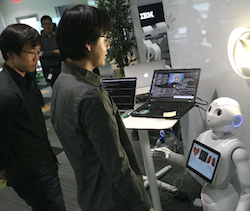
Someday, it may be common for senior living residents and their caregivers to be assisted by robots, and sensors embedded throughout living spaces may be an integral part of healthcare.
These technologies may be moving a step closer to everyday reality with IBM Research’s Thursday announcement of a prototype Multi-Purpose Eldercare Robot Assistant, or MERA, as well as a partnership in Italy to test the use of sensors in senior housing.
IBM created the prototype robot with students and faculty members from Rice University. In the company’s ThinkLab in Austin, TX, researchers will study the technology’s ability to measure vital signs such as heart rate, heart rate variability and respiratory rate in a new way — by recording video of a person’s face; answer basic health-related questions; determine whether an individual has fallen by reading the results of an accelerometer; and communicate with older adults and caregivers. The lab is designed to mimic the types of interactions older adults may have in their homes.
Smart senior living
IBM Research also has plans to study technology in real living environments, specifically senior housing, where Sole Cooperativa of Italy will test sensors’ ability to monitor the day-to-day activities of residents.
Sole will create “smart spaces” for its senior living residents, leveraging the Internet of Things and cognitive computing to identify changes in physical conditions or anomalies in environmental readings and inform caregivers of changing situations.
By monitoring atmospheric readings such as carbon dioxide and carbon monoxide levels, for instance, Sole will determine the room someone is in and how long he or she has been there, and then will leverage cognitive systems to help understand the resident’s typical day — components such as what time he or she gets up and goes to bed, or how many meals he or she eats and at what time. The goal is to provide Sole with holistic views of its residents by integrating data from sources such as traditional databases and streaming sensor data.
“This new system will be designed to help our residents live safely and independently for as long as possible,” Roberta Massi, president of Sole Cooperativa, said in the announcement. “By better understanding a person’s routines and surroundings, we can identify potential risks, personalize care and deliver precise recommendations that improve their quality of life. We can also more effectively improve our business operations by ensuring our staff is more focused on helping residents and patients as potential medical issues arise.”
Above: George Chen, center, a Rice University Ph.D. student, has his heart and respiratory rates measured by a prototype IBM Multi-Purpose Eldercare Robot Assistant as IBM Research staff member Jinho Lee, left, observes during a demonstration at the IBM “Aging in Place” research environment in Austin, TX. (Photo by Jack Plunkett/Feature Photo Service for IBM)



